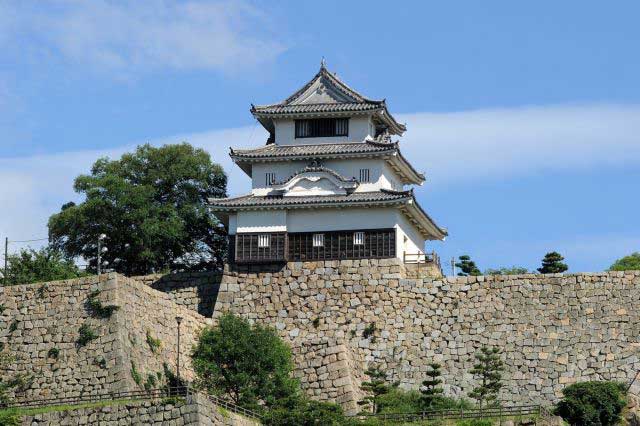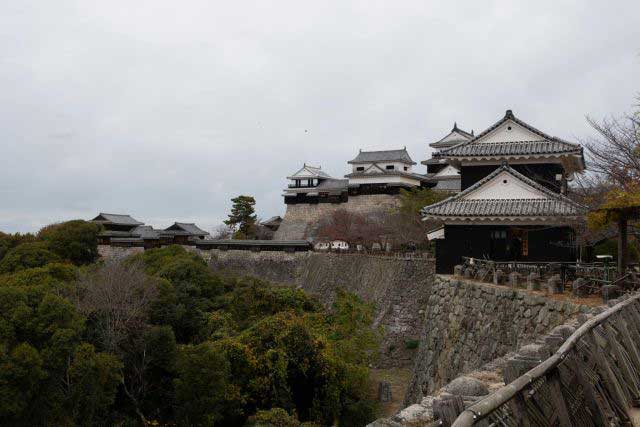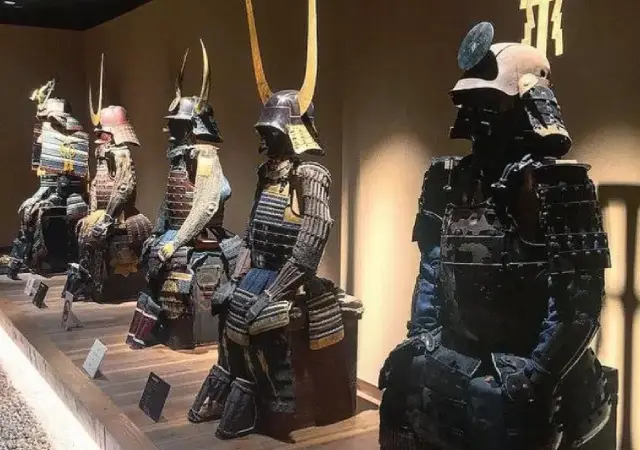
Matsumoto Castle is a designated National Treasure, located on the plains of Matsumoto City in central Nagano Prefecture. As a hira-jiro, or castle built on the plains, it necessitated an extensive system of moats, stone and earthen walls, and gatehouses for defense.
Originally, the site was a fortress used by the Ogasawara clan around 1504. It was later taken by Takeda Shingen in 1550, and subsequently by Toyotomi Hideyoshi, who awarded it to Tokugawa Ieyasu. Ieyasu reinstated the Ogasawara clan, placing Ogasawara Sadayoshi in command. Sadayoshi named the area Matsumoto before Tokugawa Ieyasu replaced him with the trusted general Ishikawa Kazumasa.
From 1590, Kazumasa began rebuilding and expanding the castle but died in 1592. His son, Yasunaga, also known as Gemba, completed the work in 1594, including the current five-story black lacquered wooden-clad tower.
The construction inside the smaller Ko-tenshu tower and the main Tenshu tower is particularly interesting. The upright pillars in the older Ko-tenshu are rounded, while those in the main Tenshu are square, indicating different construction periods. The main keep and sub-keep towers are linked by fortified watari-yagura corridors. Both the Tenshu and Ko-tenshu feature ishi-otoshi rock-dropping hatches at the corners, indicative of their wartime construction. The southeastern corner has an open-plan yagura called the Tsukimi Yagura, or Moon-Viewing yagura, built in 1634 for moon-viewing parties, alluding to its peacetime construction.
The Tsukimi Yagura was added by Matsudaira Naomasa, Tokugawa Ieyasu's grandson, for his cousin, the third Shogun Iemitsu's planned visit, which was ultimately canceled. It is said that during a moon-viewing party in the Tsukimi Yagura, the moon can be seen three times: in the sky, reflected in the moat, and in your sake cup.

Matsumoto Castle is a collection of five separate National Treasures: the main keep, the Ko-tenshu, the two adjoining corridors, and the Tsukimi Yagura. The outer walls of the tenshu complex are covered in black lacquered shitami-itabari cladding, protecting the mud walls within and giving the castle a somber appearance, especially against the backdrop of the winter snow-capped northern Alps.
In 1872, following the collapse of the feudal system and the start of the Meiji Restoration, Matsumoto Castle was slated for demolition and sold at auction. However, citizens formed a group to save the castle, successfully preserving it for future generations. In the mid-Meiji period, the castle developed a lean, prompting civic groups to repair the tower keep. Designated a National Treasure in 1952, recent improvements have included the reconstruction of several gates and walls.
At the corner of the Taiko Yagura Mon Gate and the current entrance to Matsumoto Castle stands a large, rectangular rock about 2.5 meters high and weighing an estimated 22.5 tons, known as the Genba Stone. Named after Ishikawa Genba, the samurai lord tasked with the castle's redevelopment in 1590, the stone symbolizes power and financial strength. The story goes that Ishikawa Genba, hearing laborers complain about moving the heavy rock, swiftly executed the main complainer and displayed his head as a warning, ensuring the rock was quickly and quietly moved into place.
Matsumoto Castle, also known as Karasu-Jo or Crow Castle due to its black-walled main tower and adjoining towers resembling a crow spreading its wings, is a stunning example of Sengoku period castle architecture. It is one of only five castles designated as a National Treasure and, though off the standard tourist path, remains a remarkable destination.
See also
-
Marugame Castle

Marugame is part of the so-called “Authentic Dozen,” a group of twelve castles whose donjons have survived to the present day without major reconstructions since the Edo period.
-
Iyo Matsuyama Castle

Historically, the center of Iyo Province—corresponding to today’s Ehime Prefecture on the island of Shikoku—was the city of Imabari, while the Matsuyama area was regarded as an agricultural hinterland with broad plains and low hills. During the Muromachi period, the central part of the province was governed by the Kano clan from Yuzuki Castle. With the onset of the Sengoku period, however, this clan lost its former influence and was forced to survive in the shadow of the more powerful Mori and Chōsokabe clans. After Toyotomi Hideyoshi’s forces conquered Shikoku in 1587, the northern part of Iyo Province was granted to Fukushima Masanori, one of the so-called “Seven Spears of Shizugatake.” In 1595, Masanori was transferred to Kiyosu Castle, and the lands around Matsuyama were given to another of the Seven Spears, Katō Yoshiaki, who received Masaki Castle and an income of 60,000 koku of rice.
-
Kanazawa Castle

Construction of Kanazawa Castle began in 1580 on the orders of Sakuma Morimasa, a vassal of Oda Nobunaga. The castle was built on the site of the Ikko-ikki sect's Oyama Gobo temple, which is why it is sometimes called Oyama Castle. Morimasa managed to build several moats and begin construction of a castle town. However, after his defeat at the Battle of Shizugatake in 1583, he was executed, and ownership of the castle passed to Maeda Toshiie (1538–1599).
-
Nakatsu Castle

Kuroda Yoshitaka (1546–1604) was one of the closest advisors to the legendary military commander Toyotomi Hideyoshi. He took part in key military campaigns of the late 16th century, including the campaign against Shikoku in 1585 and the campaign against Kyushu in 1587. Later, during the second campaign in Korea, Yoshitaka served as chief advisor to the commander of the invasion forces, Kobayakawa Hideaki. After Hideyoshi's death, he swore allegiance to Tokugawa Ieyasu, thereby securing his influence and patronage under Japan's new leader.
-
Edo Castle

The history of Edo Castle dates back to the Heian period, when the Edo clan built a small fort on this site. In 1457, the vassal of the Uesugi clan, Ota Dokan (1432–1486), constructed a full-scale castle here. Internal conflicts weakened the Uesugi clan, and in 1524, Ota Dokan’s grandson, Ota Yasutaka, surrendered the castle without resistance to the forces of Hojo Soun, the ambitious leader of the Hojo clan. While Odawara Castle remained the clan's main stronghold, Edo was considered a key strategic fortress.
-
Samurai Museum Shinjuku

Situated in the vibrant district of Shinjuku, the museum showcases an extensive collection of samurai armor, weapons, and cultural artifacts spanning from the Kamakura to the Edo period. The exhibits aim to convey the samurai's unwavering commitment to honor and discipline, reflecting how their spirit continues to influence modern Japanese culture.
-
Anjo Castle

Anjo Castle was built on a slight elevation at the edge of the Hekikai Plateau, about 2 kilometers southeast of present-day central Anjo City in Aichi Prefecture. Today, the surrounding area thrives on large-scale agriculture and automotive manufacturing, utilizing the expansive flatlands and its proximity to the Nagoya region.
-
Numata Castle

Numata Castle, located in Numata, northern Gunma Prefecture, Japan, has a rich and complex history. During the late Edo period, it served as the residence of the Toki clan, who ruled the Numata Domain. Over the centuries, the castle changed hands multiple times and was the site of significant battles during the Sengoku period.

